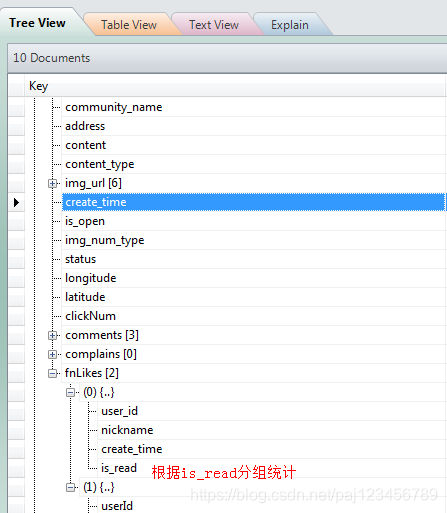
java 代码:
Aggregation aggregation1 = Aggregation.newAggregation(
Aggregation.unwind("fnLikes"),
Aggregation.match(Criteria.where("user_id").is("2016103160008110180").and("fnLikes.is_read").is(0)),
Aggregation.group("$fnLikes.is_read").count().as("未读消息数"));
AggregationResults<BasicDBObject> outputTypeCount1 =
mongoTemplate.aggregate(aggregation1, "t_table_name", BasicDBObject.class);
for (Iterator<BasicDBObject> iterator = outputTypeCount1.iterator(); iterator.hasNext(); ) {
DBObject obj = iterator.next();
System.out.println(JSON.toJSONString(obj));
}
数据脚本语法:
db.t_table_name.aggregate([ { "$match" : { "user_id" : "2016103160008110180" , "fnLikes.is_read" : 0}} , { "$unwind" : "$fnLikes"} , { "$group" : { "_id" : "$fnLikes.is_read" , "未读消息数" : { "$sum" : 1}}}])
查询内嵌数组(只返回满足条件的数据)
sql命令:
db.t_table_name.find({"user_id":"0601623000120171130"},{"comments":{$elemMatch:{"reply_to_user_id":"0601623000120171130"}}});
db.t_table_name.aggregate(
[ { "$match" : { "user_id" : "0400199004520190228"}} , { "$project" : { "comments" : 1}} ,
{ "$unwind" : "$comments"} , { "$match" : { "comments.reply_to_user_id" : "0400199004520190228"}}])
java 代码:
方法一:
//封装对象列表查询条件
List<AggregationOperation> commonOperations = new ArrayList<>();
//1. 指定查询主文档
MatchOperation match = Aggregation.match(Criteria.where("user_id").is(userId));
commonOperations.add(match);
//2. 指定投影,返回哪些字段
ProjectionOperation project = Aggregation.project("comments");
commonOperations.add(project);
//3. 拆分内嵌文档
UnwindOperation unwind = Aggregation.unwind("comments");
commonOperations.add(unwind);
//4. 指定查询子文档
MatchOperation match2 = Aggregation.match(
Criteria.where("comments.reply_to_user_id").is(userId));
commonOperations.add(match2);
//创建管道查询对象
Aggregation aggregation = Aggregation.newAggregation(commonOperations);
AggregationResults<JSONObject> reminds = mongoTemplate
.aggregate(aggregation, "t_table_name", JSONObject.class);
List<JSONObject> mappedResults = reminds.getMappedResults();
if (mappedResults != null && mappedResults.size() > 0) {
System.out.println(mappedResults.get(0).getJSONObject("comments").toJSONString());
/* history = JSONObject
.parseObject(mappedResults.get(0).getJSONObject("historyList").toJSONString(), History.class);*/
}
方法二:
Aggregation agg = Aggregation.newAggregation(
Aggregation.unwind("$comments"),//拆分内嵌文档
Aggregation.match(Criteria.where("user_id").is(userId).and("comments.reply_to_user_id").is(userId)),
Aggregation.project("comments")
);
AggregationResults<Object> results = mongoTemplate.aggregate(agg, "t_table_name", Object.class);
List<Object> resultList = results.getMappedResults();
System.err.println(resultList);








 本文详细介绍了如何使用MongoDB进行内嵌数组的高级查询,包括分组、过滤和聚合操作。通过Java代码和MongoDB查询脚本,展示了如何查询特定用户ID下未读消息的数量,以及如何从内嵌数组中筛选出符合条件的数据项。
本文详细介绍了如何使用MongoDB进行内嵌数组的高级查询,包括分组、过滤和聚合操作。通过Java代码和MongoDB查询脚本,展示了如何查询特定用户ID下未读消息的数量,以及如何从内嵌数组中筛选出符合条件的数据项。
















 316
316

 被折叠的 条评论
为什么被折叠?
被折叠的 条评论
为什么被折叠?








